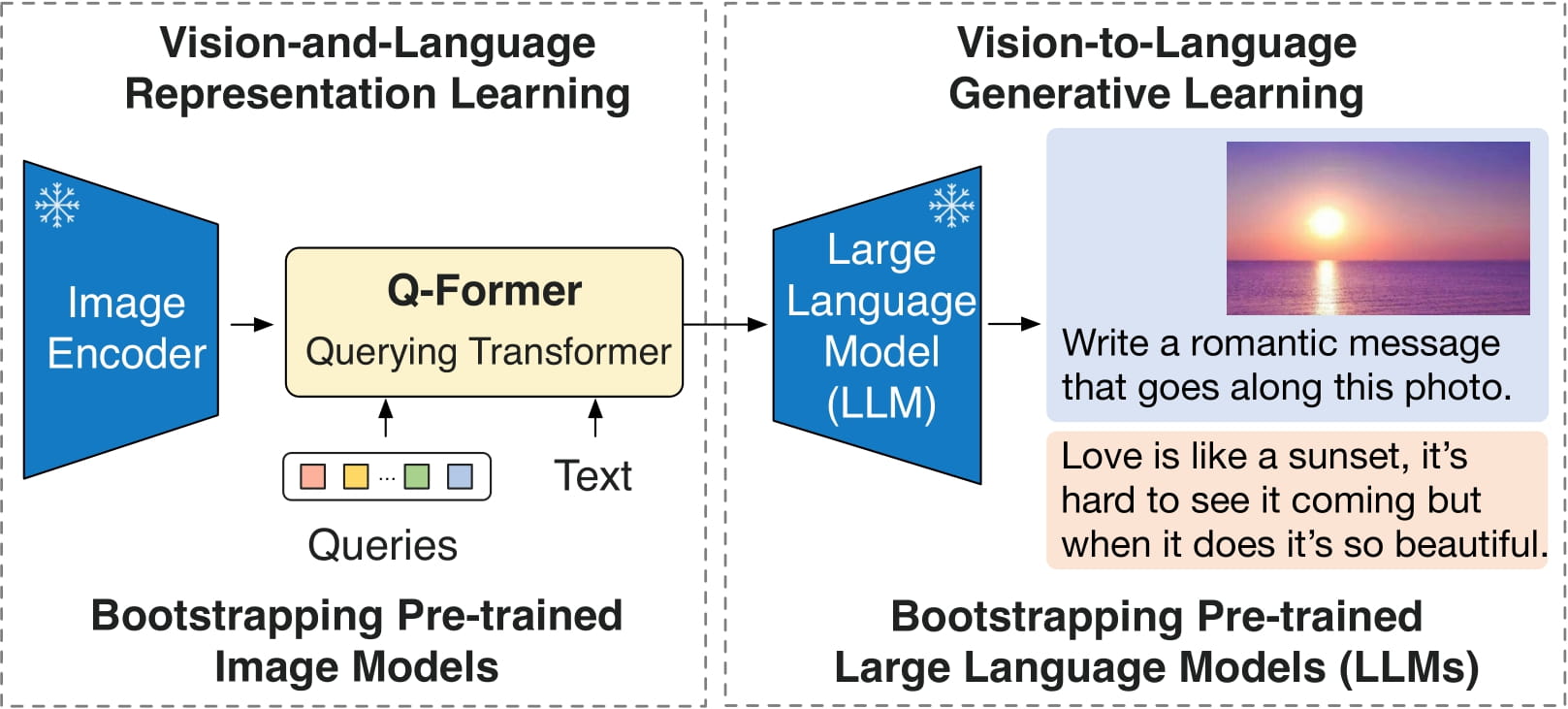---
language: en
license: mit
tags:
- vision
- image-to-text
- image-captioning
- visual-question-answering
pipeline_tag: image-to-text
inference: false
---
# BLIP-2, Flan T5-xxl, pre-trained only
BLIP-2 model, leveraging [Flan T5-xxl](https://huggingface.co/google/flan-t5-xxl) (a large language model).
It was introduced in the paper [BLIP-2: Bootstrapping Language-Image Pre-training with Frozen Image Encoders and Large Language Models](https://arxiv.org/abs/2301.12597) by Li et al. and first released in [this repository](https://github.com/salesforce/LAVIS/tree/main/projects/blip2).
Disclaimer: The team releasing BLIP-2 did not write a model card for this model so this model card has been written by the Hugging Face team.
## Model description
BLIP-2 consists of 3 models: a CLIP-like image encoder, a Querying Transformer (Q-Former) and a large language model.
The authors initialize the weights of the image encoder and large language model from pre-trained checkpoints and keep them frozen
while training the Querying Transformer, which is a BERT-like Transformer encoder that maps a set of "query tokens" to query embeddings,
which bridge the gap between the embedding space of the image encoder and the large language model.
The goal for the model is simply to predict the next text token, giving the query embeddings and the previous text.
 This allows the model to be used for tasks like:
- image captioning
- visual question answering (VQA)
- chat-like conversations by feeding the image and the previous conversation as prompt to the model
## Intended uses & limitations
You can use the raw model for conditional text generation given an image and optional text. See the [model hub](https://huggingface.co/models?search=Salesforce/blip) to look for
fine-tuned versions on a task that interests you.
### How to use
For code examples, we refer to the [documentation](https://huggingface.co/docs/transformers/main/en/model_doc/blip-2#transformers.Blip2ForConditionalGeneration.forward.example), or refer to the snippets below depending on your usecase:
#### Running the model on CPU
This allows the model to be used for tasks like:
- image captioning
- visual question answering (VQA)
- chat-like conversations by feeding the image and the previous conversation as prompt to the model
## Intended uses & limitations
You can use the raw model for conditional text generation given an image and optional text. See the [model hub](https://huggingface.co/models?search=Salesforce/blip) to look for
fine-tuned versions on a task that interests you.
### How to use
For code examples, we refer to the [documentation](https://huggingface.co/docs/transformers/main/en/model_doc/blip-2#transformers.Blip2ForConditionalGeneration.forward.example), or refer to the snippets below depending on your usecase:
#### Running the model on CPU
Click to expand
```python
import requests
from PIL import Image
from transformers import BlipProcessor, Blip2ForConditionalGeneration
processor = BlipProcessor.from_pretrained("Salesforce/blip2-flan-t5-xxl")
model = Blip2ForConditionalGeneration.from_pretrained("Salesforce/blip2-flan-t5-xxl")
img_url = 'https://storage.googleapis.com/sfr-vision-language-research/BLIP/demo.jpg'
raw_image = Image.open(requests.get(img_url, stream=True).raw).convert('RGB')
question = "how many dogs are in the picture?"
inputs = processor(raw_image, question, return_tensors="pt")
out = model.generate(**inputs)
print(processor.decode(out[0], skip_special_tokens=True))
```
#### Running the model on GPU
##### In full precision
Click to expand
```python
# pip install accelerate
import requests
from PIL import Image
from transformers import Blip2Processor, Blip2ForConditionalGeneration
processor = Blip2Processor.from_pretrained("Salesforce/blip2-flan-t5-xxl")
model = Blip2ForConditionalGeneration.from_pretrained("Salesforce/blip2-flan-t5-xxl", device_map="auto")
img_url = 'https://storage.googleapis.com/sfr-vision-language-research/BLIP/demo.jpg'
raw_image = Image.open(requests.get(img_url, stream=True).raw).convert('RGB')
question = "how many dogs are in the picture?"
inputs = processor(raw_image, question, return_tensors="pt").to("cuda")
out = model.generate(**inputs)
print(processor.decode(out[0], skip_special_tokens=True))
```
##### In half precision (`float16`)
Click to expand
```python
# pip install accelerate
import torch
import requests
from PIL import Image
from transformers import Blip2Processor, Blip2ForConditionalGeneration
processor = Bli2pProcessor.from_pretrained("Salesforce/blip2-flan-t5-xxl")
model = Blip2ForConditionalGeneration.from_pretrained("Salesforce/blip2-flan-t5-xxl", torch_dtype=torch.float16, device_map="auto")
img_url = 'https://storage.googleapis.com/sfr-vision-language-research/BLIP/demo.jpg'
raw_image = Image.open(requests.get(img_url, stream=True).raw).convert('RGB')
question = "how many dogs are in the picture?"
inputs = processor(raw_image, question, return_tensors="pt").to("cuda", torch.float16)
out = model.generate(**inputs)
print(processor.decode(out[0], skip_special_tokens=True))
```
##### In 8-bit precision (`int8`)
Click to expand
```python
# pip install accelerate bitsandbytes
import torch
import requests
from PIL import Image
from transformers import Blip2Processor, Blip2ForConditionalGeneration
processor = Bli2pProcessor.from_pretrained("Salesforce/blip2-flan-t5-xxl")
model = Blip2ForConditionalGeneration.from_pretrained("Salesforce/blip2-flan-t5-xxl", load_in_8bit=True, device_map="auto")
img_url = 'https://storage.googleapis.com/sfr-vision-language-research/BLIP/demo.jpg'
raw_image = Image.open(requests.get(img_url, stream=True).raw).convert('RGB')
question = "how many dogs are in the picture?"
inputs = processor(raw_image, question, return_tensors="pt").to("cuda", torch.float16)
out = model.generate(**inputs)
print(processor.decode(out[0], skip_special_tokens=True))
```
 This allows the model to be used for tasks like:
- image captioning
- visual question answering (VQA)
- chat-like conversations by feeding the image and the previous conversation as prompt to the model
## Intended uses & limitations
You can use the raw model for conditional text generation given an image and optional text. See the [model hub](https://huggingface.co/models?search=Salesforce/blip) to look for
fine-tuned versions on a task that interests you.
### How to use
For code examples, we refer to the [documentation](https://huggingface.co/docs/transformers/main/en/model_doc/blip-2#transformers.Blip2ForConditionalGeneration.forward.example), or refer to the snippets below depending on your usecase:
#### Running the model on CPU
This allows the model to be used for tasks like:
- image captioning
- visual question answering (VQA)
- chat-like conversations by feeding the image and the previous conversation as prompt to the model
## Intended uses & limitations
You can use the raw model for conditional text generation given an image and optional text. See the [model hub](https://huggingface.co/models?search=Salesforce/blip) to look for
fine-tuned versions on a task that interests you.
### How to use
For code examples, we refer to the [documentation](https://huggingface.co/docs/transformers/main/en/model_doc/blip-2#transformers.Blip2ForConditionalGeneration.forward.example), or refer to the snippets below depending on your usecase:
#### Running the model on CPU